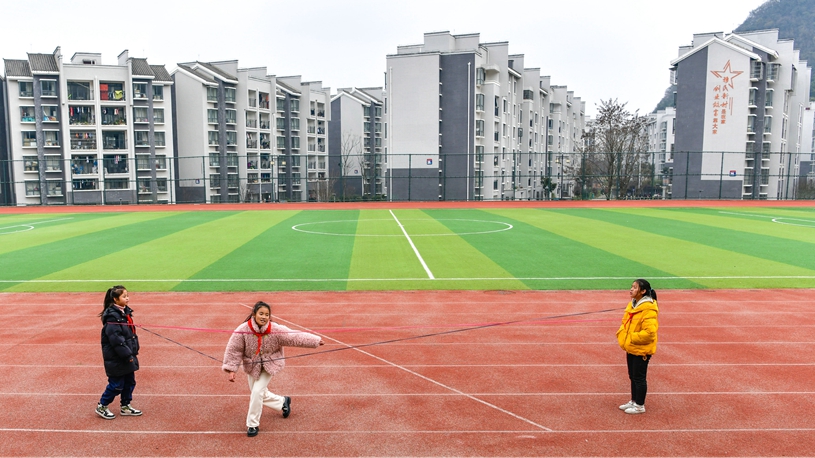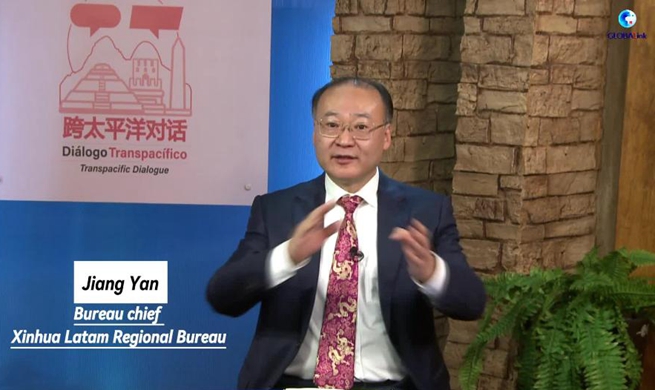
This aerial photo taken on Dec. 22, 2023 shows a wind farm in Tangshan City, north China's Hebei Province. (Xinhua/Yang Shiyao)
BEIJING, Dec. 26 (Xinhua) -- In the first half of this year, China's installed capacity of renewable energy surpassed that of coal power for the first time in its history, indicating a change in the country's energy structure.
Renewable energy installed capacity continued to grow in the second half of 2023, accounting for about half of the total installed capacity in China. Such efforts are contributing to the country's green growth by providing affordable and eco-friendly sustainable energy.
MORE RENEWABLE
According to the data released by the National Energy Administration (NEA) in late December, the country's total installed power generation capacity was about 2.85 billion kilowatts at the end of November, up 13.6 percent year-on-year.
Among them, the installed capacity of solar power generation was around 560 million kilowatts, representing a 49.9 percent increase. Wind power installed capacity was over 410 million kilowatts, up 17.6 percent year on year.
The renewable energy generation output is anticipated to reach 3 trillion kWh in 2023, accounting for almost one third of China's total electricity consumption, according to an NEA report released in November.
Minister of Ecology and Environment Huang Runqiu stated that technological advancements and widespread use of renewable energy in China have significantly reduced the cost of renewable energy.
China, for example, produces 50 percent of the world's wind power equipment and 80 percent of the world's photovoltaic module equipment. The installation cost of global photovoltaic equipment had fallen by approximately 82 percent in 2021 compared with the cost in 2010, while wind power equipment installation cost had decreased by at least 35 percent.
TECHNOLOGY UPGRADES
China's renewable energy sector has continued to upgrade renewable technologies to stimulate the rapid expansion of renewable energy installations. Many technological breakthroughs have been made in fields such as wind power, photovoltaic, and energy storage.
In July this year, for example, the world's first 16-MW ultra-large offshore wind turbine went into operation in east China's Fujian Province. One wind turbine can produce 66 million kWh per year, which is equivalent to the annual electricity consumption of 36,000 homes.
Hundreds of sensors and laser radars spread throughout the wind turbine can sense temperature, humidity, wind speed and other information to track the turbine's operational state and automatically alter the angle and generation power.
China is also working to improve its solar power generation technology. A collaboration of scientists from China and South Korea increased the efficiency of perovskite cells, a next-generation photovoltaic battery, to 26.1 percent, according to a study published in the journal Science in November.
For the first time, the study discovered that the uneven distribution of cations is the primary factor affecting the performance of perovskite solar cells. According to Pan Xu, a researcher of the study, it will help to improve the efficiency and stability of perovskite solar cells and promote their commercialization.
ENERGY STORAGE
Exploiting the potential of installed renewable energy capacity, where energy storage technology will play a key role, is a critical measure for China to enhance its future green energy supply.
An energy storage system cannot only smoothen the unstable output of photovoltaic or wind power to increase the proportion of renewable energy in the grid, but it can also collaborate with conventional power sources to provide auxiliary services such as peak and frequency regulation for power systems and improve its flexibility.
According to a draft regulation jointly issued by National Development and Reform Commission and NEA, China promotes the development of pumped storage facilities to build new energy system and new power systems, as well as the large-scale and high-proportion development of new energy, such as photovoltaic and wind power.
In Chongqing Municipality, for example, the first million-kilowatt pumped storage project in southwest China went into operation early this month. When all of the units are operational, the facility's regulation capacity will reach 2.4 million kilowatts, becoming a "super power bank" for the whole power grid in southwest China.
It will increase the efficiency and capacity of cross-regional transmission channels such as Ultra High Voltage transmission, as well as stimulate the integration of clean energy such as wind and photovoltaic power into the grid.
According to China Southern Power Grid, the overall installed capacity in storage in China has reached 50 million kilowatts at the end of June this year, with a target of 120 million kilowatts by 2030. ■












